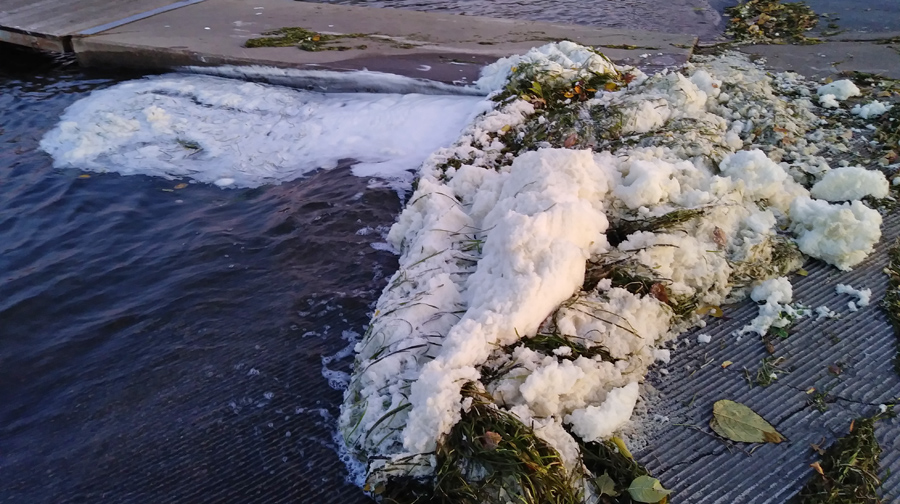New Groundwater Standards Proposed
State officials recommend standards for 16 PFAS chemicals and 6 pesticides.

Foam present in Starkweather Creek in October 2019 showed elevated levels of PFOS and PFOA. Photo courtesy of the DNR.
Gov. Tony Evers‘ administration is proposing new groundwater quality standards for 22 substances that pose a risk to public health, including 16 PFAS chemicals and six pesticides.
Found in everyday products, perfluoroalkyl and polyfluoroalkyl substances, commonly called PFAS, have raised concern because they don’t break down easily in the environment. The so-called “forever chemicals” have been linked to an increased risk of some cancers.
“These recommendations demonstrate our ongoing commitment to ensuring clean, safe drinking water for Wisconsin residents,” said DHS Deputy Secretary Julie Willems Van Dijk in a statement. “With this essential information in hand, we continue our vital work to protect this precious resource.”
Health officials detailed their recommendations in a 396-page letter to the DNR, describing the justification for each standard. The agency used federal groundwater quality standards and scientific research to develop a baseline for each substance.
The work builds on the agency’s previously recommended groundwater standard for the two most common PFAS chemicals, PFOA and PFOS. Last year, health officials recommended a groundwater quality standard of 20 parts per trillion for the two chemicals.
Now, the agency is proposing a combined groundwater standard of 20 parts per trillion for six PFAS chemicals, including PFOA and PFAS. The four additional PFAS substances include N-Ethyl perfluorooctane sulfonamideoethanol (NEtFOSE), N-Ethyl perfluorooctane sulfonamidacetic acid (NEtFOSAA), N-Ethyl perfluorooctane sulfonamide (NEtFOSA), and Perfluorooctane sulfonamide (FOSA).
The substances are a group of chemicals that are found in stain repellents, food packaging and some firefighting foams.
“The recommended standard is based on multiple studies that show NEtFOSE, NEtFOSAA, NEtFOSA, and FOSA breakdown into PFOS in both the body and the environment,” wrote health officials.
Information is limited on the group of chemicals, but research has shown that PFOS is linked to reproductive and development issues among other health issues.
More than two-thirds of Wisconsin residents get their drinking water from groundwater, according to Steve Elmore, the DNR’s director of the Bureau of Drinking Water and Groundwater.
“With these health-based recommendations and levels in hand, we can compare these levels to known PFAS-contaminated areas,” said Elmore. “As we move forward with testing drinking water wells for PFAS, we can know what level is safe or not safe to drink.”
Individual standards proposed for a dozen PFAS chemicals ranged from as low as 30 parts per trillion to as high as 450 parts per billion.
The Los Angeles Times has used the analogy that one part per billion would be like finding a packet of sugar has dissolved in an Olympic-sized swimming pool. One part part per trillion would be like finding less than one grain of sugar.
The DNR will initiate the rulemaking process to develop standards based on the recommendations. That process could take several years to complete. The agency is currently in the process of developing drinking water, groundwater and surface water standards for PFOA and PFOS.
Citizens for Safe Water Around Badger petitioned the DNR for drinking water standards for PFAS chemicals. Executive Director Laura Olah said in a statement that the group hasn’t had a chance to review the proposed limits, but they’re pleased with the recommendations from state health officials.
“They will provide much needed health-based guidance for impacted communities like Marinette where dozens of PFAS compounds have been detected in drinking water supplies, and in identifying public water supply wells that are not safe to use,” said Olah.
The DNR has requested state health officials to develop groundwater standards 11 times.
State agriculture officials also submitted several chemicals to the agency for review.
State Health Officials Propose Groundwater Standards For 22 Substances was originally published by Wisconsin Public Radio.
More about the PFAS Problem
- MKE County: County Seeks to Sue PFAS Producers, Oil Companies - Graham Kilmer - Dec 10th, 2025
- Wisconsin Reviewing EPA-Approved Pesticides For PFAS - Danielle Kaeding - Dec 9th, 2025
- State Nears Settlement with Johnson Controls/Tyco Over PFAS Spills - Danielle Kaeding - Dec 4th, 2025
- Senate Bill Promotes Soybean-Based Firefighting Foam to Replace PFAS - Danielle Kaeding - Dec 2nd, 2025
- Test Results Show High PFAS Levels in Wisconsin’s Landfill Runoff - Danielle Kaeding - Dec 2nd, 2025
- Wisconsin Communities Get $282 Million for Drinking Water Projects - Danielle Kaeding - Nov 19th, 2025
- Gov. Evers, DNR Announce $282 Million to Improve Drinking Water Quality for Wisconsinites in 74 Municipalities - Gov. Tony Evers - Nov 18th, 2025
- Cleanup of PFAS Could Cost Wisconsin Billions - Danielle Kaeding - Nov 13th, 2025
- Cleanup PFAS Without Penalizing Innocent Landowners - Wisconsin Manufacturers & Commerce - Nov 4th, 2025
- Wisconsin Lawmakers, DNR Clash Over PFAS Protections in GOP Bills - Danielle Kaeding - Oct 8th, 2025
Read more about PFAS Problem here





















